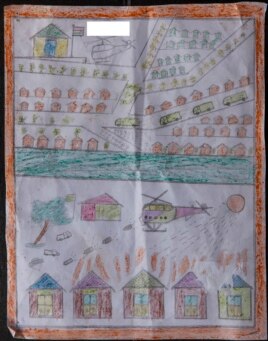16 October, 2017
In Bangladesh, the children of Rohingya refugees are making pictures.
That activity may seem perfectly normal. Except the pictures they are making show the horrors the children experienced recently as they fled Myanmar.
Anthony Lake is the executive director of UNICEF, the United Nations Children's Fund. He spoke with reporters earlier this month in the Bangladeshi town of Cox's Bazar. He said that experts believe one way for children to deal with the bad things they remember is to have them draw pictures.
The Rohingya refugees have made pictures of homes being set on fire; of helicopters shooting from the sky; and families running away from gunfire and men armed with knives.
Lake noted that, at some refugee camps, children make happy pictures. But the pictures from the Rohingya boys and girls reflect the terrible things they saw.

Drawing by a Rohingya boy, Kashem, revealing horrific experiences he endured while fleeing from Myanmar to Bangladesh.
"The pictures we have seen here are horrifying," the UNICEF chief said. "They reflect children seeing things that no child should ever see, much less endure."
Lake said he spoke with one boy who said he saw other children killed while they were playing football.
"Imagine if you were a child, and you saw that, how long would it take you to recover from that, if you ever could?" he asked.
Myanmar's army and the civilian government have repeatedly denied claims that the armed forces are harming civilians. They say they will investigate reports of atrocities if evidence is presented to them.
Late last month, State Counsellor Aung San Suu Kyi announced that military operations were suspended after September 5. But people continue crossing the border into Bangladesh. Many new arrivals are likely searching for food.
UNICEF says more than half of the refugees are children, and half of them are under five years old.
One UNICEF official gave a VOA reporter drawings she said were made by children in the Balukhali camp who went to the group's "child-friendly centers."
The children who made them are from six to 14 years old, and all were produced over the past few weeks.
Myanmar's Rakhine State is close to Bangladesh. The area has been largely closed off to aid groups and foreign observers since August 25.
Last month, Myanmar's government flew reporters to Rakhine to see where a large number of Hindu residents were buried. The government claims the Hindus were victims of the rebel Arakan Rohingya Salvation Army.
The group denied the claim.
Last Monday, the Myanmar government gave permission for a group of diplomats and U.N. officials to visit Rakhine State's Maungdaw Township. In a tweet, one diplomat said the area looked like "a ghost town."
I'm Dan Friedell.
Joe Freeman reported this story for VOANews. Dan Friedell adapted his report for Learning English. George Grow was the editor.
What do you think of the drawings by Rohingya children? We want to know. Write to us in the Comments Section or on 51VOA.COM.
______________________________________________________________
Words in This Story
horror – n. something that causes feelings of fear, dread, and shock
draw – v. to create an image or picture of someone or something
reflect – v. to show (something) : to make (something) known
endure – v. to experience (pain or suffering) for a long time
atrocity – n. a very cruel or terrible act or action
ghost town – n. an empty place with no people